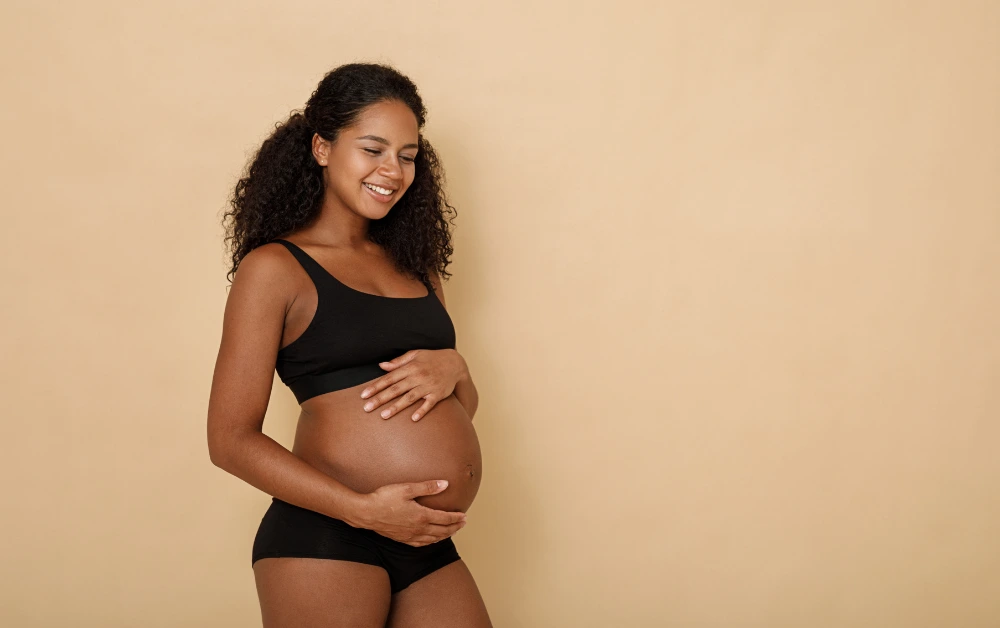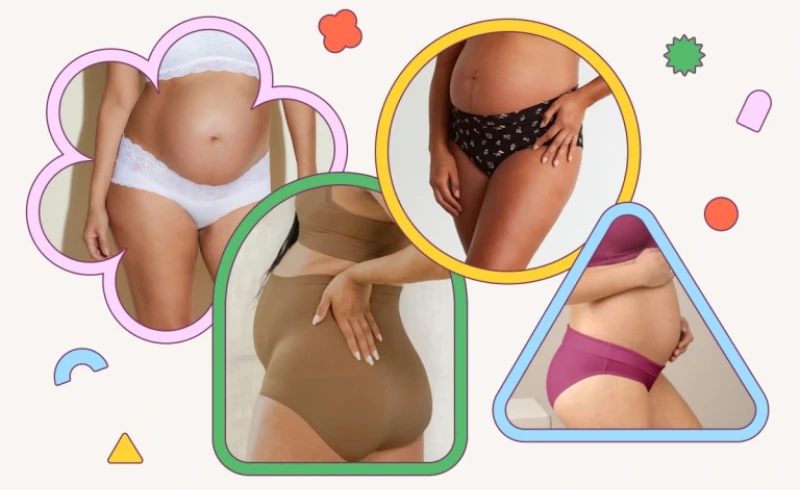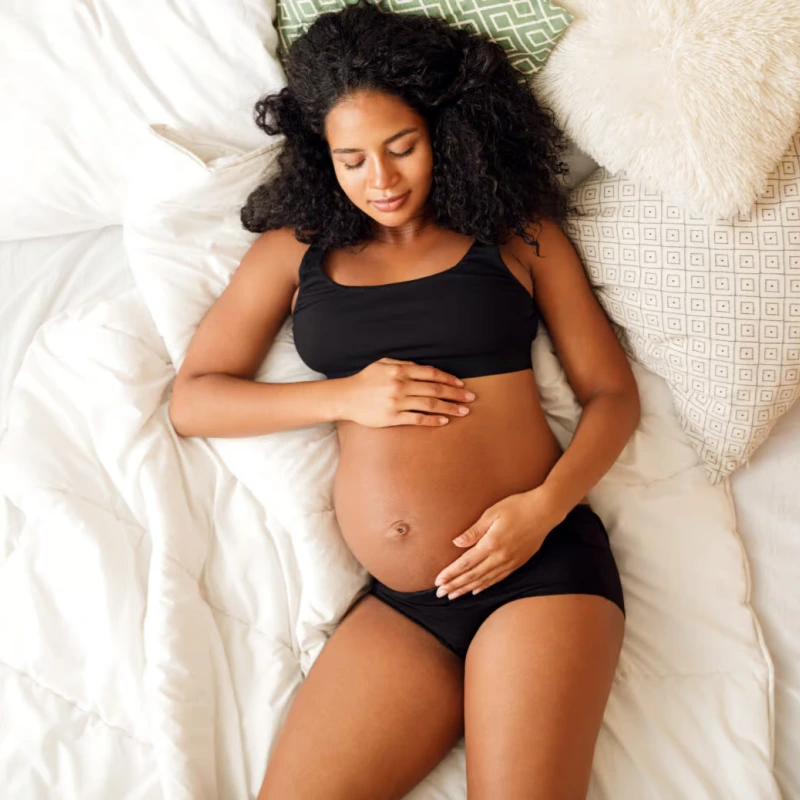
Wondering what size maternity underwear I should buy as your body changes? Most people start with their pre-pregnancy size, but you may find that pre-pregnancy size feels different as your maternity journey unfolds. Your body shifts, and comfort becomes even more important.
You might notice your favorite pre-pregnancy size maternity underwear feels snug by the second trimester. Friendtex understands that maternity comfort matters every single day. If you ever question what size maternity underwear you should buy, trust your body and focus on comfort over sticking to your pre-pregnancy size.
Key Takeaways
Start with your pre-pregnancy size, but be ready to size up as your body changes for better comfort.
Choose maternity underwear styles that fit your trimester, like low-rise for the first and high-waisted for later stages.
Pick soft, breathable fabrics like cotton or bamboo to keep your skin healthy and comfortable.
Watch for signs like tightness, marks, or discomfort to know when to buy a bigger size.
Build a small collection of maternity underwear to stay comfortable and fresh throughout pregnancy and postpartum.
What Size Maternity Underwear Should I Buy?
Sizing by Trimester
You might wonder what size maternity underwear I should buy as your pregnancy moves from one trimester to the next. Your body changes a lot, and so do your needs for comfort and support.
The right size can make a big difference in how you feel every day. Let’s break down how sizing and styles shift as your pregnancy progresses.
Here’s a simple table to help you see how maternity panties and pregnancy underwear styles change by trimester:
Trimester(s) | Style/Type | Coverage & Fit Description | Material Composition | Sizing Notes & Support Features |
|---|---|---|---|---|
First Trimester | Low-rise or Under-the-bump | Sits below your belly, gentle fit, doesn’t press on your growing bump | Cotton/spandex blends are common | You can often wear your regular size, but some people size up for extra comfort |
Second & Third Trimester | Over-the-bump briefs, high-waisted | High waistbands cover your belly, full rear coverage, and extra support for your growing bump | Nylon/spandex or cotton blends | These styles offer more smoothing and support, especially as your belly pops and your skin gets sensitive |
All Trimesters | Fold-over waistband briefs | Waistband can be worn low or pulled over your bump, moderate to full coverage | Cotton/spandex blends | Adapts to your changing shape, great for all stages and even postpartum |
All Trimesters | Seamless and thong styles | Low-rise, minimal to moderate coverage, seamless for comfort under clothes | Nylon/spandex blends | Stretchy and lightweight, but thongs may not be the best if you’re prone to infections |
Tip: If you’re not sure what size maternity underwear you should i buy, start with your pre-pregnancy size. If you feel snug or uncomfortable, try going up a size for a better fit. Many people find that adjusting sizes based on trimester helps them stay comfortable.
Adjusting for Body Changes
Your body doesn’t just grow in one place during pregnancy. You’ll notice changes in your belly, hips, and sometimes even your thighs. These changes can make your regular underwear feel tight or uncomfortable. Maternity panties are designed to stretch and move with you, so you don’t have to worry about pinching or digging in.
Here are some common changes that affect how your maternity underwear fits:
Your belly grows and your waistline expands, especially in the second and third trimesters.
Regular underwear often has tight elastics that can dig into your skin or press on your belly.
High front panels in regular underwear might feel uncomfortable as your bump grows.
Maternity panties use stretchy, soft, and breathable fabrics like cotton or bamboo. These materials help keep you cool and comfortable.
You might gain weight in different areas, like your hips or thighs, so you may need to buy pregnancy underwear in a larger size than you expected.
If you have sensitive skin or a C-section scar, you may prefer high-waisted maternity panties for extra coverage and gentle support.
Some people find that buying maternity underwear one or two sizes larger than their pre-pregnancy size works best. Others prefer to stick with their usual size but choose styles with more stretch. The most important thing is to listen to your body and choose what feels right for you.
Note: If you’re wondering how to choose maternity pants or panties, focus on comfort, breathability, and support. Friendtex offers a wide range of maternity underwear styles and sizes, so you can find the perfect fit for every stage of your pregnancy.
Choosing the right size maternity panties isn’t just about numbers. It’s about how you feel. If your underwear feels too tight, leaves marks, or rides up, it’s time to size up or try a different style. Your comfort matters most, so don’t be afraid to experiment until you find what works for you.
Sizing Guidelines for Pregnancy Underwear

How to Measure?
Getting the right fit starts with knowing your current measurements. Your body changes during pregnancy, so it’s a good idea to measure before you buy new maternity underwear. Here’s how you can do it:
Use a soft measuring tape.
Stand up straight and relax your body.
Measure your hips at the widest part, usually around your buttocks.
Measure your waist at the narrowest point, above your belly button but below your rib cage.
Write down these numbers. You’ll use them to compare with the size guide on the Friendtex website. Friendtex makes it easy by offering a clear size chart on every product page. If your measurements fall between two sizes, go with the larger one. This gives you more comfort and room to grow.
Tip: Your measurements might change as your pregnancy progresses. Check them again if you notice your underwear feels tight or leaves marks.
Using Size Charts
Once you have your measurements, check the sizing guidelines for pregnancy underwear on the Friendtex site. Their size charts are consistent and reliable, so you can trust that the size you pick will match what you receive.
Friendtex designs maternity underwear with gentle compression and soft waistbands that adapt to your changing shape. This means you get a comfortable fit that moves with you.
If you’re between sizes, always size up for extra comfort.
Look for styles that offer stretch and flexibility.
Make sure your pregnancy underwear doesn’t dig in or ride up. You want freedom of movement and no pinching.
Friendtex emphasizes comfort and fit, so you can feel confident choosing their maternity underwear throughout your pregnancy. Remember, the best fit is the one that feels good on your body right now.
Maternity Underwear Styles and Materials
Friendtex Maternity Underwear Features
When you look for maternity knickers, you want options that fit your changing body and keep you comfortable every day. Friendtex offers a wide range of styles, so you can always find the right fit for each stage of maternity.
You’ll see briefs, boyshorts, thongs, and even seamless maternity knickers in their collection. These styles adapt to your growing belly and curves, giving you the support you need without sacrificing style.
Here’s a quick look at popular maternity underwear styles and their market trends:
Maternity Underwear Style | Popularity / Market Share | Growth Trend / Reason |
|---|---|---|
Bras | Largest market share in 2023 (over 35% of global revenue) | High demand for support during maternity and breastfeeding |
Panties | Expected the highest growth rate | Seamless, breathable panties are a top choice for maternity comfort |
Shapewear | Gaining traction | Offers shaping and support during and after maternity |
Nursing Bras | Designed for breastfeeding | Adds convenience and support for new moms |
Maternity Leggings | Favored for flexibility | Everyday comfort during maternity |
You’ll love how Friendtex maternity knickers stay in place and move with you. Many women say these maternity knickers become their go-to choice for daily wear. The seamless and high-waisted options give you gentle support, especially as your belly grows.
If you want extra coverage or need support after birth, you can try shaping or postpartum maternity knickers.
Tip: Try different styles of maternity knickers as your body changes. You might prefer low-rise in early maternity and high-waisted or seamless styles later on.
Best Fabrics for Comfort
Choosing the right fabric makes a huge difference in maternity comfort. Friendtex uses soft, breathable, and stretchy materials to keep you feeling good all day. Here are the most recommended fabrics for maternity knickers:
Cotton (including organic and Supima cotton): Soft, breathable, and gentle on sensitive skin. It helps prevent irritation and keeps you cool.
Bamboo viscose: Hypoallergenic, moisture-wicking, and temperature-regulating. It’s perfect for maternity knickers if you want cooling comfort.
Modal: Naturally breathable and soft, great for sensitive skin during maternity.
Nylon and polyester blends: Moisture-wicking and quick-drying, these blends help prevent discomfort and infections.
Spandex/elastane: Adds stretch, so your maternity knickers adapt to your changing shape.
Eco-friendly materials like organic cotton and bamboo offer extra benefits. They’re gentle, chemical-free, and durable, so your maternity knickers stay soft and supportive through many washes. Many women notice less irritation and more comfort when they switch to these fabrics during maternity.
If you want the best comfort, look for maternity knickers with a blend of organic cotton and a little spandex. You’ll get breathability, stretch, and a fit that lasts through every stage of maternity.
When to Buy the Right Size?
Signs to Size Up
You might wonder if it’s time to buy the right size underwear as your body changes. Your comfort is the best guide. Many people notice a few clear signs that their current underwear just isn’t working anymore. If you spot any of these, it’s probably time to look for the right size underwear:
Skin bulges around your hips or love handles. This means your underwear is too tight.
Seams dig into your thighs and leave marks. You might even feel your leg movement is restricted.
You feel uncomfortable or restricted. If your underwear leaves marks on your skin after you take it off, it’s a sign to size up.
Constant wedgies or sagging material. Both mean your underwear doesn’t fit right.
Waistbands that feel loose or roll down. This can happen as your belly grows and your shape changes.
Tip: Maternity panties should fit snugly but never tightly. If you feel any pinching, pulling, or discomfort, don’t wait—try a bigger size or a different style. Your body deserves comfort every day.
When to Start Wearing Maternity Panties?
You don’t need to rush out and buy maternity underwear the moment you find out you’re pregnant. Most people find their regular underwear works just fine during the first trimester. As you move into the second trimester, your body starts to change more quickly.
This is when many people notice their old underwear feels tight or uncomfortable. The second trimester is the most common time to start shopping for maternity panties that offer more stretch and support.
When you reach this stage, focus on comfort and flexibility. Look for underwear that adapts to your growing belly and hips. If you notice any of the signs above, it’s a good idea to buy the right size before discomfort sets in. Choosing the right size underwear early can make a big difference in how you feel throughout your pregnancy.
Maternity Panties for Each Trimester

First Trimester Fit
In the first trimester, your body starts to change, but you might not notice a big difference in your belly yet. Most people find that their regular underwear still works, but you may want to try maternity panties for extra comfort.
Maternity panties in this stage often look like your usual underwear, but they use softer fabrics and have more stretch. You can try under bump maternity knickers if you want something that sits below your belly. These give you gentle support without pressing on your stomach.
Tip: If your regular underwear feels tight or leaves marks, switch to maternity panties early. You will thank yourself for choosing comfort from the start.
Second Trimester Adjustments
The second trimester brings more noticeable changes. Your belly grows, and you may feel your hips widen. This is when maternity panties really shine. Many people switch to maternity knickers with a higher waistband for better support. Over bump maternity knickers are a popular choice now.
They cover your belly and help you feel secure. You might also want to try pregnancy panties with seamless designs. These prevent irritation and keep you comfortable all day.
Here’s a quick comparison:
Style | Best For | Comfort Level |
|---|---|---|
Under bump maternity knickers | Early to mid pregnancy | High |
Over bump maternity knickers | Mid to late pregnancy | Very High |
Seamless maternity panties | All trimesters | High |
You may need to size up for the best fit. Listen to your body and pick maternity panties that move with you.
Third Trimester Comfort
The third trimester is all about comfort. Your belly is at its biggest, and you need maternity panties that stretch and support. Maternity knickers with wide waistbands and soft, breathable fabrics work best.
Many people love overbump maternity knickers now because they offer gentle support for your bump and lower back. Pregnancy panties with extra stretch help you avoid pinching or rolling waistbands.
Remember: Your comfort matters most. Choose maternity panties that make you feel good, even on days when everything feels tight.
You might want to have several pairs of maternity knickers on hand. This way, you always have a clean, comfortable option ready. Maternity panties are not just about fit—they help you feel confident and supported through every stage of maternity.
How Many Maternity Underwear to Buy?
Building Your Wardrobe
You might wonder how many maternity panties you actually need. The answer depends on your laundry routine, your comfort, and how often you want to change. Most people find that building a small collection of maternity panties makes life much easier during pregnancy and postpartum care. Here’s a quick table to help you decide:
Scenario | Recommended Number of Pairs |
|---|---|
Washing every other day | 5-7 pairs |
Washing once a week | 10-14 pairs |
Postpartum recovery (lochia) | 7-10 pairs |
Starting to test styles | 3-5 pairs |
If you wash your maternity panties every other day, five to seven pairs should keep you covered. If you prefer to do laundry once a week, aim for ten to fourteen pairs. During postpartum recovery, you’ll want seven to ten pairs of postpartum underwear for extra changes.
When you’re just starting, try three to five pairs of different maternity panties to see which styles feel best.
You might notice that your needs change as your pregnancy progresses. Some days, you’ll want seamless maternity panties for comfort. Other days, you’ll reach for high-waisted maternity panties for support. Having a mix of styles helps you stay comfortable through every stage of maternity and postpartum care.
Tip: Keep a few extra maternity panties on hand for those unexpected leaks or laundry delays. You’ll thank yourself later!
When to Replace Maternity Panties?
Maternity panties work hard for you, so knowing when to replace them is important. You should plan to refresh your collection every six to twelve months.
If you wear your maternity panties often, consider replacing them every six months to keep things soft and sanitary. Here are some signs it’s time for new maternity panties or postpartum underwear:
The fabric loses stretch or feels loose.
You spot holes, thinning, or frayed seams.
Stains or odors linger after washing.
The fit changes or feels uncomfortable.
You notice irritation or chafing.
Organic cotton maternity panties tend to last longer and feel more breathable. Washing your maternity panties in cool water and air drying them helps extend their life. Rotating several pairs of maternity panties also keeps each pair in better shape.
Remember, your body changes a lot during maternity. If your maternity panties start to feel tight or unsupportive, don’t wait—replace them for better comfort and hygiene. Fresh maternity panties and postpartum underwear help you feel your best every day.
When to Stop Wearing Underwear During Pregnancy?
Comfort and Health
You might wonder if you really need to wear underwear during pregnancy. The answer depends on your comfort and health. Many health experts suggest wearing breathable cotton underwear while pregnant. Cotton helps keep you cool and dry, which lowers your risk of yeast infections.
These infections happen more often during pregnancy because your hormones change. If you wear underwear made from non-breathable fabrics, like silk or synthetic blends, you might trap moisture and increase the chance of infection.
Some women choose to skip underwear for extra comfort. Going without can help keep the area dry and well-ventilated. This may lower your risk of irritation or infection, especially if you wear loose, sweat-wicking pants or skirts.
Just make sure you keep your clothes clean and change them often. Tight clothing without underwear can cause rubbing or even fungal infections, so always listen to your body.
Tip: Choose what feels best for you. If you feel more comfortable without underwear, and you keep up with hygiene, it’s safe to go commando during pregnancy.
Personal Preferences
Your personal preference matters most when it comes to underwear during pregnancy. Many women stop wearing underwear because it feels too tight, causes irritation, or just feels uncomfortable as their bodies change.
You might find that ditching underwear gives you a sense of freedom and helps you reconnect with your body. Some women say it boosts their confidence and comfort, especially when dealing with heat or sensitive skin.
Here are a few reasons you might decide to stop wearing underwear during pregnancy:
You feel restricted or too warm in regular underwear.
You want to avoid irritation or heat rash.
You prefer the feeling of loose, breathable clothing.
You want more control over your comfort and body image.
Medical professionals agree that the style or cut of underwear does not matter as much as your comfort. If you love a certain style, like thongs or briefs, you can keep wearing them as long as they feel good.
If you want to stop wearing underwear, that’s fine too. Just focus on comfort and choose breathable fabrics for your outerwear.
Remember: Pregnancy is your journey. You get to decide what brings you the most comfort each day.
Conclusion
You can start with your pre-pregnancy size, but always adjust as your body changes. Comfort comes first, so choose soft, breathable maternity underwear like Friendtex for every stage. Here are some quick tips:
Pick stretchy, natural fabrics for comfort and health.
Try different styles to match your shape and needs.
Focus on support and easy-to-wear designs.
Listen to your body and enjoy this special journey—your comfort matters most!
FAQ
How do I know if my maternity underwear fits right?
You should feel comfortable all day. The waistband should not dig in or roll down. If you see red marks or feel pinching, try a bigger size. Your underwear should move with you and never feel tight.
Can I wear maternity underwear after pregnancy?
Absolutely! Many people keep wearing maternity underwear during postpartum recovery. The soft, stretchy fabric feels gentle on your skin. You get extra support while your body heals. You might even find them more comfortable than regular underwear.
How often should I replace my maternity underwear?
Check your underwear every few months. If you notice loose fabric, stretched-out waistbands, or holes, it’s time for new pairs. Fresh underwear keeps you comfortable and helps prevent irritation.
What’s the best fabric for sensitive skin during pregnancy?
Look for organic cotton or bamboo. These fabrics feel soft, breathe well, and help prevent irritation. Friendtex offers several eco-friendly options that work great for sensitive skin.
Do I need special care instructions for maternity underwear?
Yes! Wash your maternity underwear in cold water. Skip fabric softeners. Air dry them to keep the fabric stretchy and soft. This helps your underwear last longer and stay comfortable.


